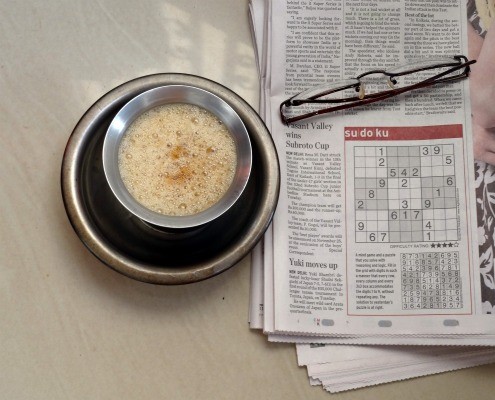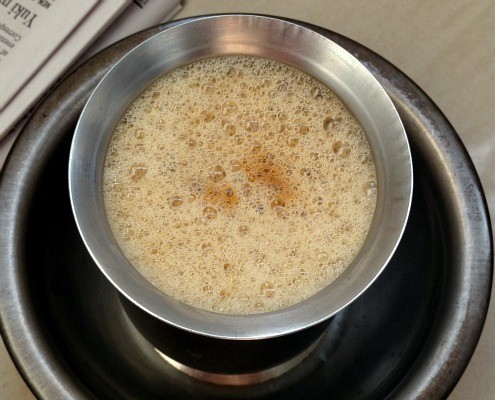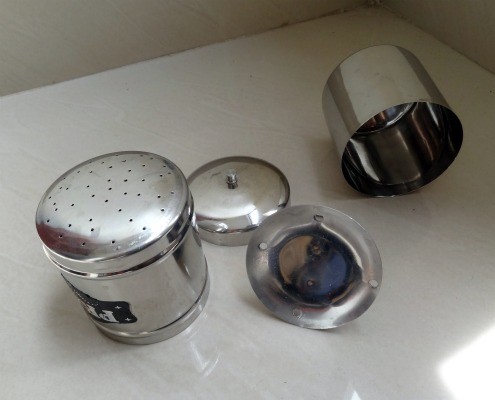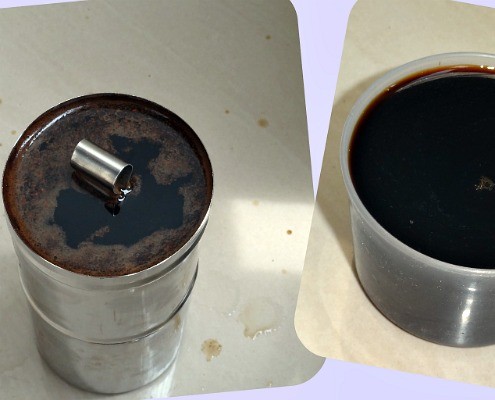Priya Sreeram on how to make The Perfect South Indian Filter Coffee.
By Priya Sreeram
I am not addicted to my morning coffee, but still have 2 coffee filters in my kitchen. That says a lot about coffee or should I say Kaapi. Fuel booster, morning must-have, call it what you want, the beverage is accorded an iconic status in a South Indian household and understandably so. I remember reading sometime back, R K Narayan’s (one of the greatest Indian Author) love for coffee – Once during his trip abroad he was asked how he would like his coffee- black or white? To which he replied – “I want it neither, black nor white, but brown, which ought to be the colour of honest coffee, that’s how we make it in South India. Now you know why this beverage is so special.
My father always says, ” making a perfect cup of kaapi is an art that’s perfected over time” and I agree. Oh to have a cup of steaming hot coffee from my mother’s hands is bliss. My mom is famous for making the degree coffee – I always used to wonder why that name; she told me that the first time the decoction ( the potent stuff that percolates from the filter) is said to be of first degree because of its immense flavour and strength and hence the coffee prepared with it became Degree Coffee.
Is there anything to beat the taste of a South Indian Filter Coffee? Cafe Coffee Day, Barista take a hike- your espressos/cappuccinos ain’t have the same inherent taste and aroma, that a kaapi has. The heady buzz of the cuppa, with a rich, intense, not so sweet taste and most importantly a lingering slightly sharp (bitter ?) aftertaste is what makes it tick. So what’s in it – Freshly ground coffee beans & chicory (optional) when mixed with boiling water and passes through the filter slowly as decoction – that magic potion makes Kaapi an elixir of life.
My take on why coffee became kaapi in Tamil – absence of the syllable ‘ph’ in the written language meant substituting ‘pi’ in place of ‘ph’, and hence – kaapi
Coffee Powder for the cuppa is generally a blend of dark roasted coffee beans (and) chicory. Coffee beans are usually from the plants of peaberry,robusta and arabica grown in the fertile hills of Tamilnadu, Kerala & Karnataka, while the chicory acts as a flavouring agent, thickens the decoction and adds to the overall taste of the coffee. The roots of the chicory plant are sliced, dried, ground and roasted to a rich brown color like coffee beans. When blended with coffee they add to the color, aroma and body of the drink by extracting more flavor from the coffee powder. It offsets the bitter taste of the coffee by infusing its own semi-sweet taste. In fact people who love coffee but don’t want the caffeine fix, can use ground roasted chicory root as a coffee substitute.Using chicory for blending with the roasted coffee beans is entire a matter of choice. I know many people who get pure coffee powder and chicory separately and mix it in a proportion they prefer (say70 : 30) and then use it for making their cup.On the other hand there are coffee lovers who drink their cuppa using pure coffee powder without mixing chicory. They consider blending chicory with coffee as blasphemy. Well, to each his own.
How do I like my coffee – I am not averse to coffee having a little chicory blend ; many brands with a variety of coffee:chicory mix is easily available on the store shelves and I experiment with these brands for a stimulating taste travel.
Coming to the filter that makes the decoction – it is a double deckered stainless-steel vessel – the lower half is a cup/retainer of the drip (decoction). The upper part has a perforated base that nestles the coffee powder.There is a pierced pressing cap like thing with a stem that helps in filtering the mix and finally a lid. Heaped spoons of the coffee powder is put in to the perforated upper cup, enough boiling water is added and the pressing stem is placed and the lid closed.
Now we wait patiently for the potent decoction to get collected in the lower half and it usually takes time (anytime from 1 hr or so – it again depends upon how small or big the holes of the upper container). Exactly why, the decoction is prepared overnight, so that your dose of morning fuel is ready when you want it. Once the percolation is complete, store it separately and add boiling water again for the second or third collection. Please keep in mind that the first dose of decocotion is very strong and thick and the coffee made with it is heavenly.The subsequent collections will not have the same punch as the first dose. Nevertheless they can be collected to add it to the milk (if you prefer) while making your cup.
One of the things that make this beverage unique is the way it is served- we like it to have it in the classic davarah and; tumbler – a stainless steel wide dish and glass (South Indian version of saucer and cup) . Pouring the hot milk, decoction and sugar back and forth in a davarah and tumbler in a huge arc like motions of the hand not only ensures that the ingredients mix well but also helps the drink become warm enough to be enjoyed and creates the oh so famous froth/foam that makes the drink popular. A visit to the roadside coffee vendor in South India is a must – not only to savour the most magical coffee but also to experience the art of making the frothy drink.
Sitting on the verandah/patio, sipping the morning cuppa and getting lost in the morning newspaper, now that’s what I call BLISS
Some tips to make that cuppa heavenly:
- The filter should be totally dry before adding the coffee powder, you can slightly heat the upper chamber directly over the flame for complete drying ; this also ensures that there is no blockage in the perforation.
- Don’t fill the upper chamber with lots of coffee powder; generally 3 to 4 heaped spoons is enough (depending on the size of filter) ; otherwise it will slow down the percolation process and will result in a very low quantity of the decoction.
- After you add the coffee powder to the upper part of the vessel, gently pat it down with a spoon or tap the upper cup on the kitchen counter a few times to let the powder settle well. This removes any vaccuum and allows better drip. The pressing stem is also to ensure that the powder is settled well
- Once you mix the milk & the decocotion never heat the coffee , else the taste tends to suffer. That is why piping hot milk is used for the coffee.
- You can refrigerate the excess decoction for use later in the day. Just be sure to heat the decoction separately before adding it to the milk. Do that (preferably) by placing the cup holding the decoction in a vessel containing hot water.
- In case you have collections of the decoction from the second or third percolation, you can add it to the milk (as required) while making your cup.
My hubby and sister shared this interesting information for all the Coffee Connoisseurs. Coffee Beans found in the droppings of a nocturnal cat like animal called as Civet that prowl the coffee growing regions of South- East Asia is getting phenomenal attention as the coffee made from those beans is said to be smooth, chocolaty and devoid of any bitter after-taste. They are also the most expensive coffee beans in the world. For more info read this.
PrintFilter Coffee (Kaapi)
- Total Time: 3 hours 10 minutes
- Yield: 1 1x
Description
The Perfect South Indian Filter Coffee
Ingredients
For the decoction
- Heaped Spoons of Coffee Powder – 3 to 4
- Boiling Water
For the Coffee (to make 1 cup)
- Piping Hot Milk – 2/3 mug/cup/glass
- First dose of strong decoction (from above) – as required
- Sugar – to taste
Instructions
- Pour the milk in to the mug or steel glass. Add decoction and sugar as required. Swish it in a davarah (saucer like dish) to get the froth and to ensure mixing of all ingredients. Drink Hot.
- Quantity of decoction depends upon how you like your coffee- light or strong
- Prep Time: 3 hours
- Cook Time: 10 mins
















Delicious… Eager to try it out at home. Once tried this artisan filter coffee powder from http://www.tastebells.com/cafe-chic … Quite impressed with the overpowering aroma, great taste and value for money… Came freshly roasted and within 2 days… Loved every aspect of the service… Must try
Hello Madam,
Thanks for the nice explanation.
I dont have the time to prepare coffee powder. I want to purchase ready made powder which gives the same filter coffee aroma. Which coffee powder I have to select?
Absolutely does give any idea how the coffee is made, no measurement.
Beautiful post Priya!
I am neither a coffee enthusiast nor a coffee addict, but I still do own couple of Kauai filters myself, the reason – I love making coffee for others :)
Learnt about the expensive civet droppling coffee (called Kopi Luwak) from the movie Bucket List (Morgan freeman & Jack Nicholson)
thanks a ton radhika ! yup bucket list is one movie that I wanna watch coz of morgan freeman and will look out for the coffee mention !
Steaming Filter Kappi and Sudoku -Thumps Up
thanks pushpa !
Wow, never tried this, but it sounds fantastic. Have to add to breakfast plans this weekend.
Thanks Harry ! Hope you enjoy the aromatic drink South Indian way